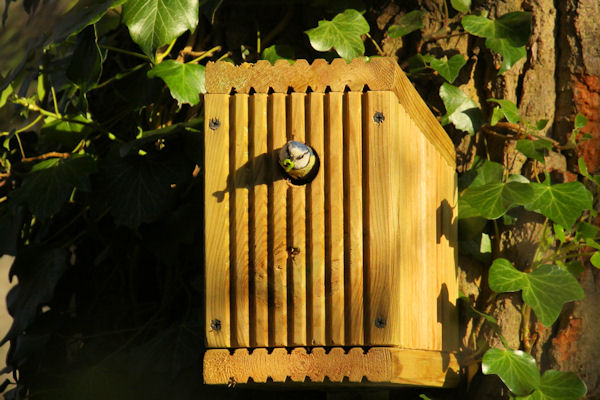March in Bicknor Wood
In big news, on 18th March, a Peregrine Falcon was seen flying over. It is unlikely to become a regular fixture, most probably just passing through. Apologies for the poor quality of the picture.
The Chiffchaff has returned. After spending the winter in southern Europe or northern Africa, this tiny bird makes the journey north to the UK in time for spring. It was also noted singing weakly on the 18th. After a quiet weekend, it was heard singing again from 23rd onwards.
Bird boxes were quiet during the first half of the month. During the second half of the month however, Blue Tits were seen making repeated visits with nesting material to no. 5, 22 and 19 and looking proprietorial in no. 1.
On 23rd, a Eurasian Wren was seen investigating the same box as the robin looked on. The robin objected, but the wren was persistent. On 24th, wren seen visiting box without interference from robin.
The Blue Tits in the burnt tree have proved the age old saying that "less is more". They have excavated so much soft wood that they have inadvertently knocked through and opened up another entrance lower down. They still persist, with the two-door nest, but it will be prone to predators. Still excavating on 30th.
They are not happy about their potential new neighbours as a pair of Eurasian Treecreepers are carrying nesting materials into the space behind some peeling bark on the same tree. Wood flakes for construction on 23rd/24th, then softer, lining feathers on 27th.
More territorial conflict was observed along the south path on 22nd as a Eurasian Nuthatch chased a Great Spotted Woodpecker away. The woodpecker had been showing an interest in the hole used last year by our resident nuthatch pair. Nuthatches frequently return to a nest site in the following year, especially if it was successful. Last year, they fledged two chicks from this hole. On 24th, both nuthatches seen plastering mud in the hole, reducing the aperture to protect against the woodpeckers and Eurasian Magpies raiding the nest.
On 30th nuthatch seen bringing in nesting material to a different hole. Another pair, or the same pair that changed their minds?
At least 3 magpie nests are potentially in use. A couple are being re-used from last year and a new one is in the early stages of construction. It is possible that the apparent re-use of last year's nests could be a resource recycling exercise.
In news from Outer Bicknor, a Common Woodpigeon's egg fragment was found on 18th and squabs seen out of the nest on 23rd. European Greenfinches have been seen and heard singing territorially. If I hadn't been so surprised by the falcon, I would probably have put the greenfinch down as a prediction for next bird to join the Bicknor Wood bird list.
More peacock butterflies are waking after over-wintering as adults. The first comma was seen on 22nd.
This picture is doing a double shift as lesser celandine and a red-rumped bumblebee. The buff-rumped bumblebee can potentially be seen year round and has been seen frequently since February.
Mammals are most commonly represented here by the rabbits and squirrels. Look for the squirrel kittens. Noctule bats have been recorded from 5th March with Soprano Pipistrelle and Common Pipistrelle seen over the wood on 31st.
The wildflowers waited until the traditional bad luck from the ides of March were past before pushing through. Rosebay willowherb was first noted on the16th and the first wood anemones on the 18th.
Blackthorn blossom can be seen on the hedges along Gore Court Road, So we might assume that it can also be seen along the edge adjacent to the new Redrow development. A large blackthorn is determinedly producing blossom on the north side of the wood despite having fallen some time ago. New shoots are showing on the brambles. While the shoots are young and tender, they can be eaten. It's the sort of thing one might do once, just to try it, but if you are not an avid forager, you will probably find that once is enough. Dog's mercury is showing. The male and female flowers of this species are borne on separate plants. Do not eat!
The catkins on the silver birches started to show over the last few days of the month, from 26th.






















Comments
Post a Comment